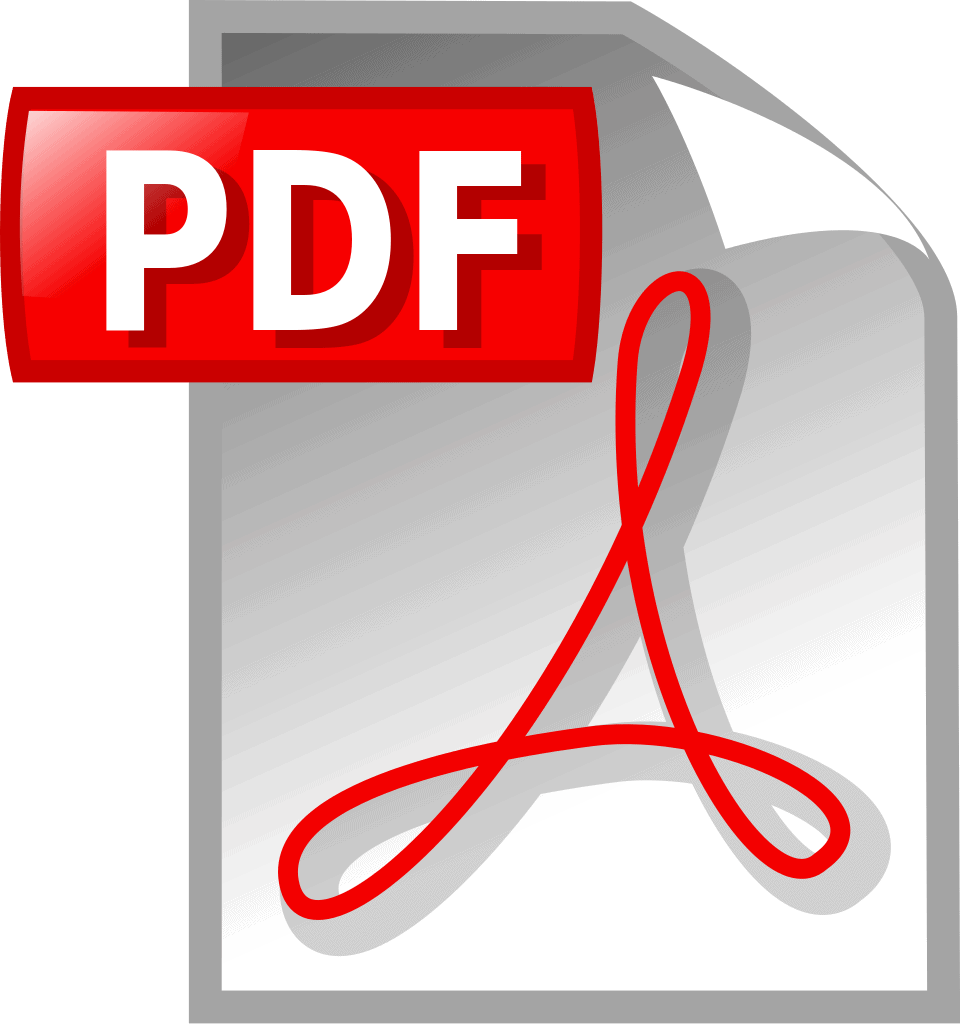Chapter 4 Linking old and new index series
4.1 Introduction
4.1 This chapter discusses index compilation methods when introducing a new classification of goods and services in the CPI. Chain-linking of index series across weights updates and changes in the classification is needed to provide users of the CPI with comparable time series. Section 4.2 discusses the key issues when chain-linking CPI series and suggests minimum requirements to observe when linking and publishing chain-linked series. Section 4.3 presents the standard method for chain-linking CPI series when weights are updated. Sections 4.4 and 4.5 discuss in more detail methods to link CPI series with different classifications of goods and services and the introduction of new elementary indices and new higher-level indices in the CPI. Section 4.6 advises in the case where elementary aggregates cannot be assigned to only one category of the new classification and must be split into new ones to align with the new classification. Section 4.7 summarises the key points of the chapter.
4.2 Tables 8 – 11 provide examples of index calculations and linking of index series. The tables in Excel format are available on : Changes in the classification of goods and services in the consumer price index | UNECE
4.2 Linking of CPI series
4.3 Two index series can be linked together through an overlapping period and brought to the same index reference period. The old and the new index series make a chain-linked index. When the weights of the CPI are updated, the CPI series based on the new set of weights must be linked to the CPI series based on the old set of weights to calculate chain-linked index series that can be compared over time. Such long-time series are crucial for many users of the CPI.
4.4 Chain-linking is also an opportunity to introduce sample updates, methodological changes, and changes in the classification of goods and services in the CPI, including the introduction of new elementary aggregates and new higher-level indices. These tasks are often undertaken simultaneously at the time of reweighting to minimize overall disruption to the time series and any resulting inconvenience to users of the indices.
4.5 It is recommended to implement classification changes together with a regular CPI update. This means that in addition to changes in the classification, the new and old CPI will be based on different expenditure weights, and changes in the sample or methods may be introduced. Chapter 9 in the CPI Manual discusses the procedures to update CPI weights and to link the new series in more detail. In general, CPI series are calculated and published according to the new classification from a period in time onwards. To meet user needs for long time series, NSOs should publish indices for the new classification not only moving forward but also for periods in the past. To this end, series from the old CPI can be used and linked to the corresponding series from the new CPI.
4.6 The decision on the level at which CPI series have to be chain-linked to compile and publish continuous time series depends on the CPI publication policy and user needs. The main principle is that two series can be linked together if they are assessed to be comparable. As a minimum, the CPI should be linked at the all-items level. This means that the new CPI (all-items level) is linked to the old CPI (all-items level) to provide users with a continuous time series for overall consumer price inflation. The old CPI may not be fully identical to the new CPI because of differences in the classification and aggregation structure in weights and samples. However, the coverage of both the old and new CPI may be deemed sufficiently comparable so that linking at the all-items level can be undertaken.
4.7 If there is a significant difference in the coverage between the old and new CPI, linking should be done with care. For example, the new CPI may have a much larger geographical coverage, whereas the previous CPI may have only covered the capital city of a country. Sometimes, a change in the classification may be implemented together with an increased product coverage by including, for example, owner-occupied housing or other products that were previously out-of-scope. Suppose that the general price trend with the new coverage does not significantly deviate from the price trend of the previous CPI coverage. In that case, it may be acceptable to link together the old and new CPI despite the difference in coverage.
4.8 An alternative would be to start the new CPI without linking it to the previous CPI. Another alternative proposed in the CPI Manual (paragraph 9.123) would be to produce a variant of the new CPI with a coverage that is restricted to the coverage of the old CPI and link these series together. This means that there will be two different CPI series: the ‘new’ CPI series with no back data and the ‘new’ CPI series adjusted to the old coverage, linked to the ‘old’ CPI.
4.9 To meet user needs, it is recommended to chain-link higher-level price indices of the CPI, e.g. for broad expenditure groups such as food and beverages, clothing and footwear, housing, transport, and for more detailed level of aggregation when possible. For linking higher-level CPI series at a given level of aggregation, it will be necessary to identify a corresponding series from the old CPI with a coverage that is sufficiently comparable to allow chain-linking the two series and comparison over time.
Box 3 Switching from COICOP99 to COICOP18
When switching CPI from COICOP99 to COICOP18, it is common practice to compile and publish continuous chain-linked time series for the overall CPI and at the division (2-digit) level. It may be decided to link the new divisions 01-11 (COICOP18) to the old divisions 01-11 (COICOP99). The new division 13 (COICOP18) could be linked to the old division 12 (COICOP99), whereas the new division 12 (COICOP18) could remain a new series without any back data and be designated as a ‘new’ index. When designating division 12 (COICOP18) as a new index, it is important to include a footnote in all publications so users are informed. Alternatively, the new division 12 could also be linked to the old division 12. To date, several countries have implemented COICOP18 and have taken this approach to link the old and new data series.
Instead of linking at the divisional level, it may be possible to align the old series at a detailed level to the new classification. The CPI Manual (paragraph 9.117) notes the following when switching to COICOP18:
In most instances, the old CPI includes the same detailed components as the COICOP, but the components appear in different divisions. If this is the case, it may be a straightforward task to develop a concordance between the old classification and the COICOP. The old index series at the detailed level can be recompiled using the old series weights to reflect the COICOP structure at the 13 Division level. The recompiled old series can then be linked with the new COICOP series to form a time series going back to the point of the previous revision
4.10 The COICOP18- COICOP99 correspondence table links the 5-digit subclasses in COICOP18 to the 4-digit classes in COICOP99. When preparing the implementation of a new classification, from the perspective of this chapter, it is recommended to build a table that maps existing elementary aggregates to the most detailed level in the new classification, the subclass level in COICOP18. This will help to identify elementary aggregates that can be allocated to one and only one category in the new classification to work with one-to-one or many-to-one mappings and avoid as much as possible one-to-many mappings where an existing elementary aggregate must be split into two or more new elementary aggregates. One-to-many mappings where elementary aggregates are divided into two or more new elementary aggregates are discussed in more detail in section 4.4.
4.3 Linking methods
4.11 Before looking into the introduction of classification changes, this section presents the standard method for linking index series. A change in the classification introduces additional complexity, but the same linking methods can be applied.
4.12 The CPI is compiled in two steps. First, elementary indices are compiled for the elementary aggregates using typically an unweighted index formula (e.g., the Jevons index). In the second step, the elementary indices are aggregated into higher-level price indices, using the expenditure shares as weights. An elementary aggregate is understood as the lowest level of groups of goods or services for which expenditure weights are assigned and held constant for a period of one year or more. These elementary aggregates are structured according to the new classification that is used for the CPI.
4.13 When linking CPI series, it is helpful to distinguish between the price, weight and index reference periods of the series. These are defined as follows:
The price reference period is the period for which the prices appear in the denominators of the price relatives. Depending on circumstances such as the frequency of weight updates, the price reference period may be a month, a quarter, or a year.
The weight reference period is the period to which the expenditure data underlying the weights of the index refer.
The index reference period is the period for which the value of the index is set at 100.
4.14 The CPI from previous periods must be chain-linked to the new series to provide users with a continuous time series. To link the two series, there must be an overlap period between the old and the new series. Suppose that the old index (P0:k) has been calculated based on a set of old weights (wib) with period 0 as the index reference period until period k. A new index series (Pk:t) is calculated from period k until period t with k as price and index reference period based on a new set of weights (wic). Period k is the ‘link’ period that allows the old and new series to be combined into a chain-linked index (P0:t) from period 0 to t. Both the old and the new higher-level index is obtained as the expenditure-weighted average of the elementary indices (Pi). The chained-linked index can then be calculated as:
(1)
4.15 The new higher-level index is linked (multiplied) to the higher-level index of the old index to obtain the chained higher-level price index that measures the price development from period 0 to period t. When the series are denoted with 100 as a reference, the expressions on the right side of (1) must be divided by 100. A decision must be made on the index reference period of the chain-linked index series. In equation (1), the chained-linked index is expressed with respect to the old index reference period. Another option would be to work with a new index reference period by rescaling the series to that period.
4.16 The index reference period is typically an entire year, although it can also be a quarter or a month. In case of a significant change in classification, the NSO may decide to publish the updated index with a new index reference period. Setting the index back to 100 (a new index reference) signals to users that there are substantive changes to the CPI, such as a new classification system or updated methodologies. In general, it is a good practice to periodically update the index reference period of the CPI, e.g., every five or ten years, even without major methodological or other changes.
4.17 Table 8 illustrates this procedure. For simplicity, the index in the example has a quarterly frequency. However, the same principles and methods apply whether the CPI is monthly or quarterly. The CPI consists of five elementary price indices (EA1-EA5) that are grouped into two higher-level price indices (A and B). The CPI with year 0 as the index reference period is compiled until the end of year 1 based on the old weights.
4.18 From year 2, new weights are introduced, and the new series are calculated with Q4 year 1 as the index reference period. The chained higher-level indices are obtained by linking (multiplying) the series with Q4 year 1 as the overlapping period. The chained index is based on the old index reference period (year 0 = 100). Alternatively, the higher-level indices can be rescaled to another index reference period by dividing through by the average index level of that period. In the example, the higher-level indices are rescaled to year 1 as the index reference period. Note that the chain-linking and rescaling of the index reference period does not change the month-on-month or the year-on-year rates of change.
4.19 In the examples in tables 8– 10, it is assumed that the new CPI from Q1 year 2 is calculated with the last period of the old CPI (Q4 year 1) as the index reference period to be chain-linked to the old CPI series. If this is not the case, for instance, if the new CPI uses the average of year 1 as the index reference period, the new series must be re-scaled to the last period of the old CPI (Q4 year 1) as the reference period. Chapter 9 in the CPI Manual includes more details and examples of chain-linking index series, including the use of an annual overlap period for linking old and new index series.
Table 8 Chain linking
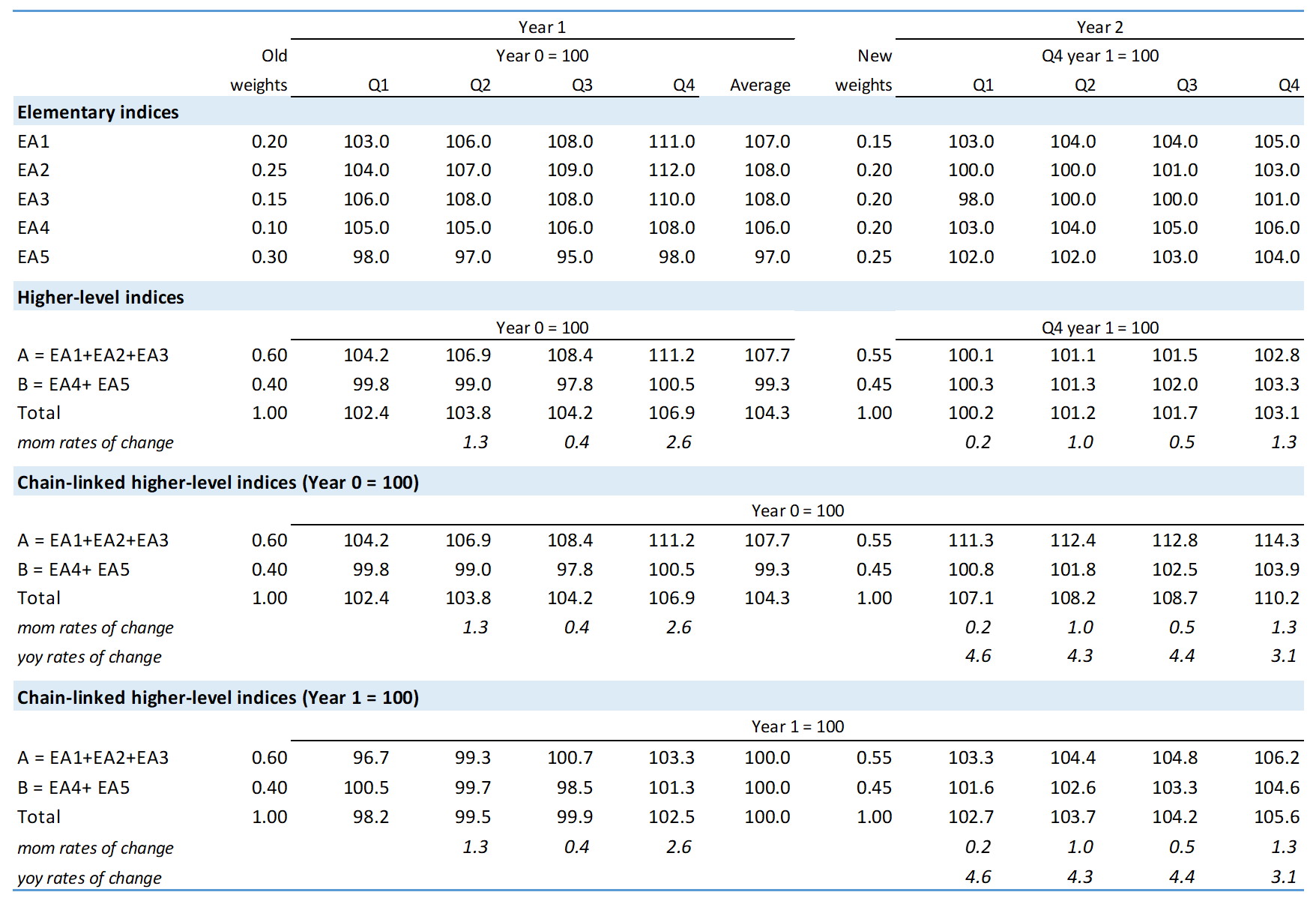
4.4 Linking CPI series with different classifications
4.20 Instead of linking higher-level indices, it is often possible to regroup the elementary indices according to the new classification and recalculate higher-level indices up to the overall CPI backwards with the new classification. This method of recalculation improves the comparability of the series to be linked. The method is illustrated in Figure 2. The old series are calculated up to period t. These series can now be re-arranged to better match the new classification using the old weights. The new series are calculated from period t onwards based on the new weights. The old and new series, both calculated with respect to the new classification, can now be linked together.
Figure 2 Linking two series based on different classifications

4.21 Figure 2 illustrates the case where the same elementary aggregates are included in the old and the new classifications. The only changes are that the weights of the elementary aggregates are updated, and they are grouped in different higher-level indices in the new classification. In this case, it will be possible to regroup the elementary indices according to the new classification and calculate higher-level indices backwards based on the old weights and the new classification. These higher-level series can then be linked to the higher-level indices of the new CPI based on the new classification and the new weights to obtain a long and comparable time series. This procedure is illustrated in Table 9.
Table 9 Linking two series based on different classifications
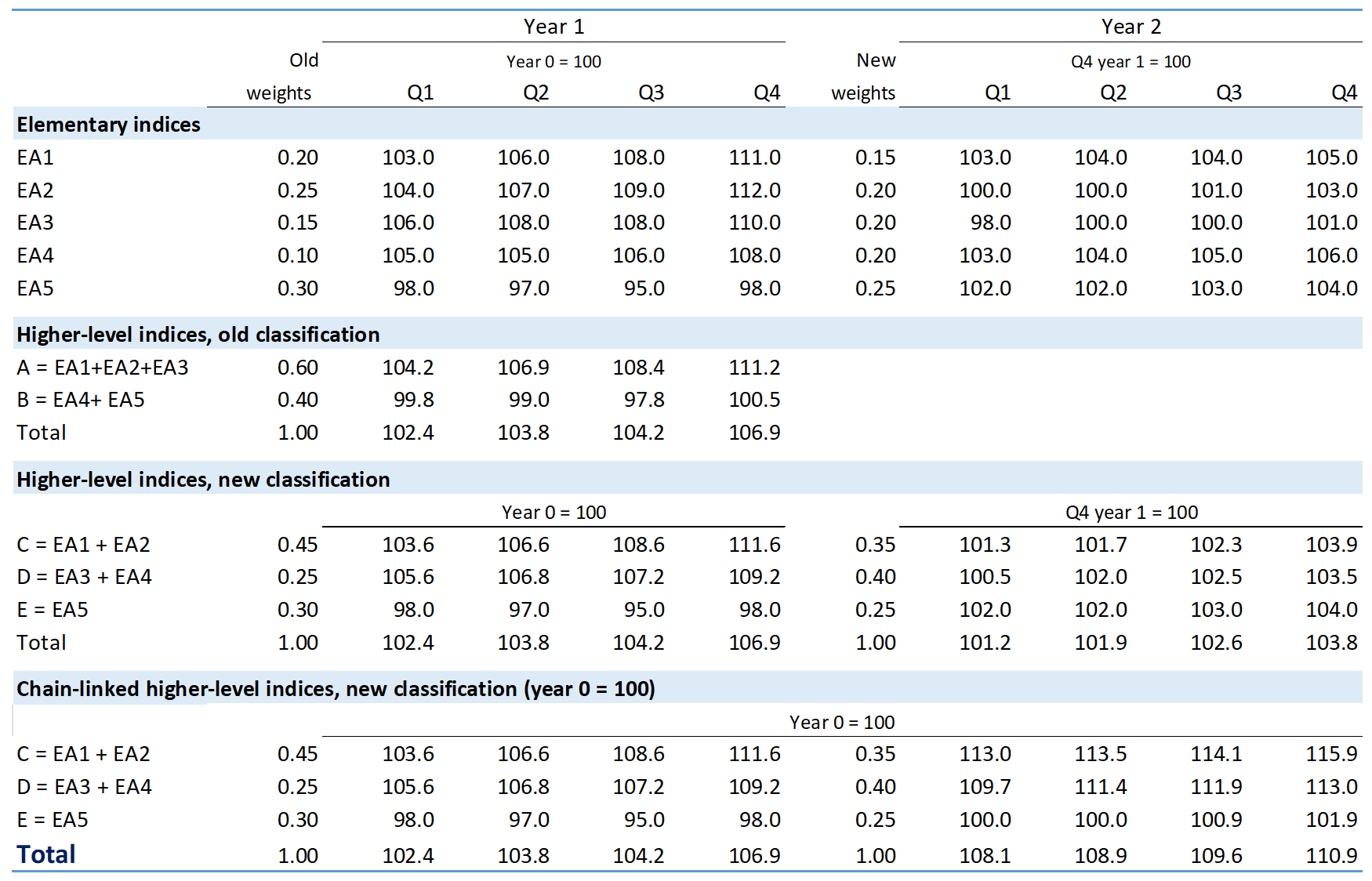
4.22 In the example in Table 9, there are five elementary aggregates which are grouped differently in the old and new classifications. Historically, the old series have been calculated according to the old classification, where the elementary aggregates are grouped into two higher-level indices, A and B. In the new series, the elementary aggregates are grouped into three higher-level indices, C, D and E. Higher-level price indices, according to the new classification, can now be calculated backwards by regrouping the elementary aggregates according to the new classification using the old weights. After the recalculation of the historical period, the old and new index series can be chain-linked to obtain comparable long-time series using equation (1).
4.23 Note that the higher-level indices of the old CPI are calculated using the old weights, and the higher-level indices of the new CPI are based on the new weights. Hence, while the index series are chain-linked into long-time series, the two series of the chain-linked index are still based on different sets of weights.
4.24 It is also important to note that the overall CPI for the historical period (year 1) does not change as a result of the recalculation according to the new classification. The old CPI at the all-items level will be identical when calculated according to the old and new classifications. This is because the same elementary indices are used, they are only grouped differently, in which case the method to calculate higher-level indices from elementary indices is ‘consistent in aggregation’ (see the CPI Manual, paragraph 8.51).
4.25 Most countries do not revise their CPI series after publication. It is important to note that the regrouping of elementary and higher-level indices, as illustrated in Table 9, is a re-calculation and not a revision of past series.
4.5 Introducing new elementary and higher-level price indices
4.26 It may be necessary to introduce new elementary aggregates and higher-level indices to cover a new classification. This is illustrated in Table 10. In this example, the old CPI consists of four elementary aggregates (EA1-EA4) that are grouped into two higher-level indices (A and B). When implementing a new classification, four new elementary aggregates (EA5-EA8, shown in red in the table) and two new higher-level indices (C and D) are introduced in the new CPI. The example illustrates the following cases.
Introducing new elementary aggregates in an existing higher-level index
4.27 A new elementary aggregate may be included in an existing higher-level index if this is considered not to impact the coverage of the index. In the old CPI, higher-level index A is based only on two elementary aggregates (EA1, EA2). In the new classification, a new elementary index (EA5) is included. It is assumed that the higher-level indices in the old and the new CPI are comparable, even if a new elementary index is included. In this case, the new elementary aggregate (EA5) can be included in the calculation of the higher-level index A with Q4 year 1 as the index reference period. The higher-level index (based on EA1, EA2 and EA5) is then linked with the old higher-level index (based on EA1 and EA2) in Q4 year 1 to obtain a long chain-linked series. This method corresponds to assuming that the new elementary index developed as the parent higher-level price index (A) in the historical period, i.e., as the average price development of the elementary indices (EA1, EA2) that were available in year 1. For this reason, it will not have an impact on the historical series of the overall CPI.
Combine new and old elementary aggregates into a new higher-level index.
4.28 In the example, a new higher-level index C is composed of two existing elementary aggregates (EA3, EA4) and a new elementary index (EA6). The higher-level index in the new CPI is first calculated based on the three elementary aggregates (EA3, EA4, EA6) with Q4 year 1 as the index reference period. If the new higher-level index can be considered comparable with the old higher-level index B (based on EA3, EA4), the two series can be chain-linked. This solution is illustrated in Table 10. It shows that the higher-level index C is carried backwards by the development of the old higher-level index B.
4.29 This corresponds to assuming that the new elementary index developed as the parent higher-level price index (B) in the historical period, i.e., as the average price development of the elementary indices (EA3, EA4) that were available in year 1 in the example. It will not impact the historical CPI series.
4.30 It could also be possible to obtain or estimate prices for the new elementary aggregate for the historical period and calculate the elementary index on this basis. However, this would result in a change in the parent higher-level index (C) and eventually also in the overall CPI. In this case, if there are significant changes, the recommended practice would be to recalculate the CPI and its higher-level indices for the historical period (at least one year) and publish the series.
Table 10 Introducing new elementary and higher-level price indices
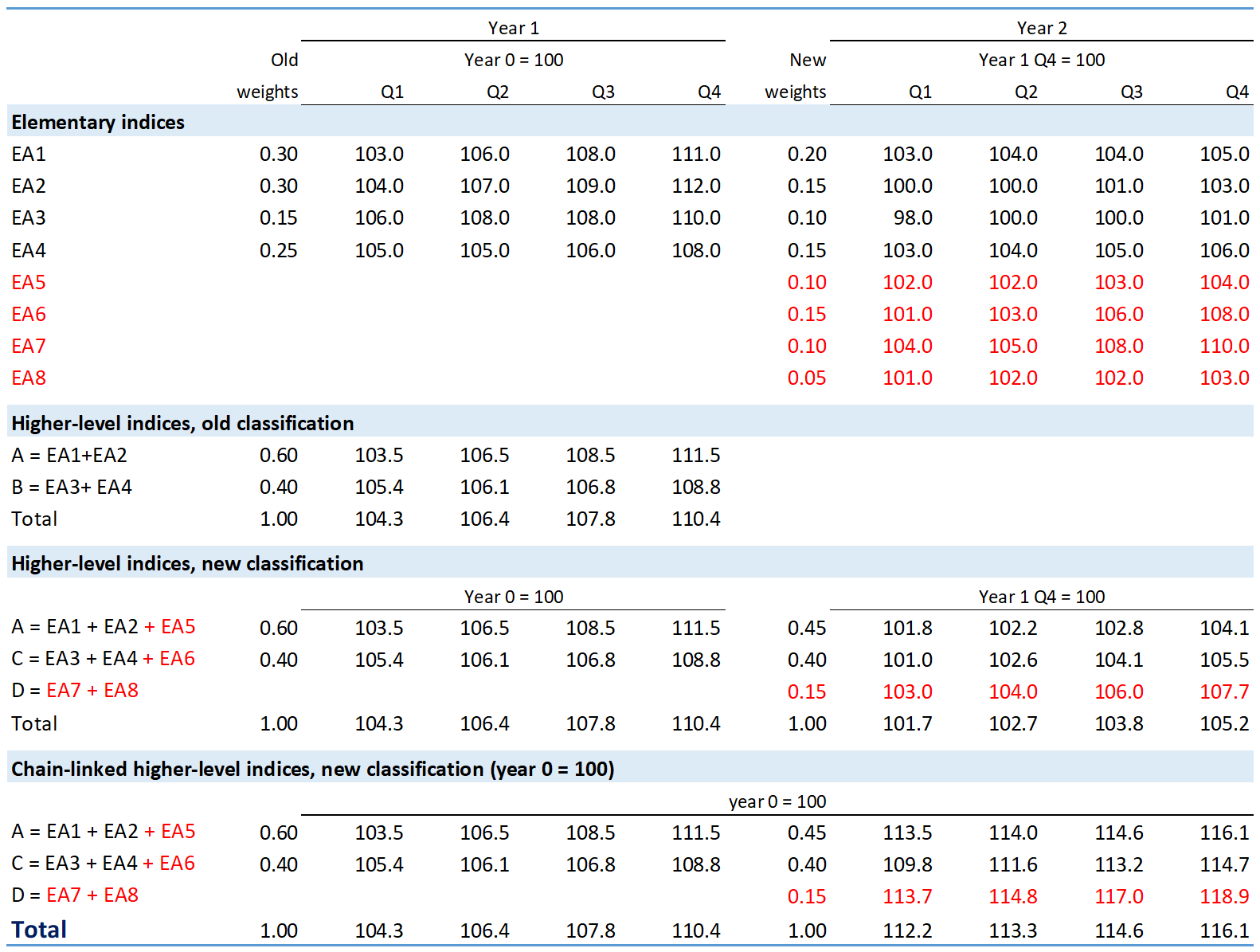
Introduce a new higher-level index based only on new elementary aggregates.
4.31 In Table 10, a new higher-level index D is composed of two new elementary aggregates (EA7, EA8). This could be an example of an extension of the scope of the CPI to include a new product group in the CPI. The new higher-level index is calculated from Q1 year 2 with Q4 year 1 as the index reference period, in the same way as the other higher-level indices.
4.32 If the new CPI is chain-linked to the old CPI index reference period, a choice must be made regarding which value in the linking period (Q4 year 1) should be used to introduce the new higher-level index in the chain-linked index. It cannot be linked to the index with the value 100 since this would create a discrepancy in index levels compared to the parent index, which, in the example, is the total CPI. In this case, the value of the total CPI in Q4 year 1 (110.4) can be used for linking the new higher-level index into the index series with the old reference period (year = 0). This ensures that the inclusion of the new higher-level index does not impact the overall CPI in an unwarranted way due to a difference in the level of the new index compared to the other series in the index.
4.33 However, the introduction of new elementary aggregates and new higher-level indices may represent a significant extension of the scope of the CPI so that the CPI based on the new classification should not be carried backwards with the development of the old CPI with a different (smaller) scope.
4.34 It may also be that users of the CPI would need series for the new higher-level for a historical period (at least one year). Hence, in case of a significant change in the scope of the CPI, the recommended practice would be to recalculate the CPI and its higher-level indices for the historical period (at least one year) and publish the series.
4.6 Splitting elementary aggregates
4.35 When mapping the existing elementary aggregates to a detailed new classification, it may not be possible to build a one-to-one or many-to-one correspondence table, where all elementary aggregates are allocated to one and only one category in the new classification. One or several existing elementary aggregates may be assigned to several new categories in the new classification (one-to-many or many-to-many mappings).
4.36 Two such examples are shown in Figure 3. In the first example (one-to-many), an existing elementary aggregate for ‘Fish, live, fresh, chilled or frozen’ is split into two new aggregates on ‘Fresh and chilled fish’ and ‘Frozen fish’ to fit into the new classification. In the second example (many-to-many), ‘E-bikes’ were previously included with ‘motorcycles’ but are now combined with ‘bicycles’.
Figure 3 Examples of one-to-many and many-to-many classification changes
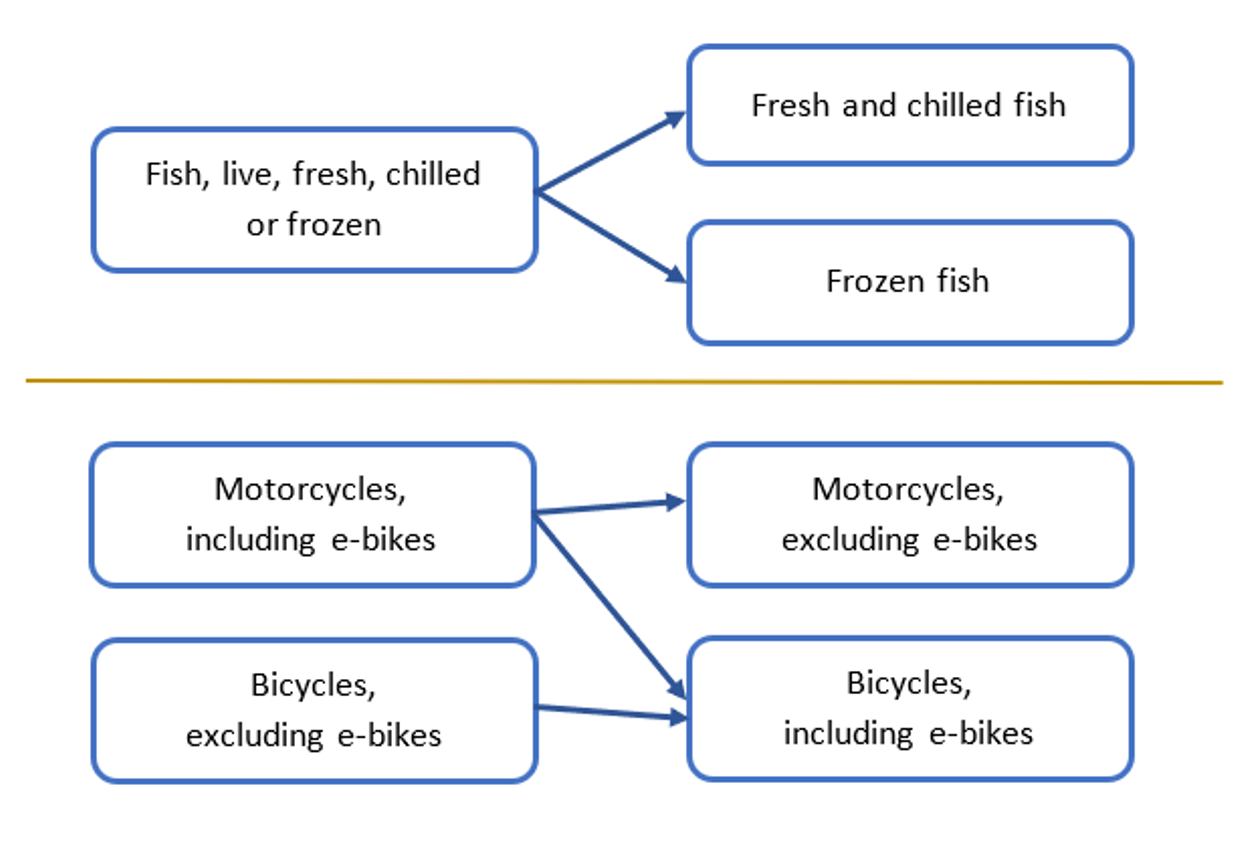
4.37 In cases of one-to-many and many-to-many classification changes, there are different options.
Option 1: Link at the level above. In the first case, we may decide not to link at the level of ‘Fresh and chilled fish’ and ‘Frozen fish’, but only at the level above. In the second case, we may decide not to provide a historical series for the new categories ‘Motorcycles, excluding e-bikes’ and ‘Bicycles, including e-bikes’ and to link the series only at the level above (for example, ’motorcycles including, e-bikes‘ and ‘bicycles, excluding e-bikes‘ combined).
Option 2: Link series with the most comparable coverage. In the first case, a possibility would be to link both the new series ‘Fresh and chilled fish’ and ‘Frozen fish’ to the old series ‘Fish, live, fresh, chilled or frozen’. In the second case, we may link the new series ‘Motorcycles, excluding e-bikes’ with the old series ‘Motorcycles, including e-bikes’ and link the new series ‘Bicycles, including e-bikes’ with the old series ‘Bicycles, excluding e-bikes’.
Option 3: Re-calculate past data to align with the new definitions. We may re-calculate the old series to better align with the new definitions. In the example in Figure 3, we would need to estimate the price series in the past for ‘Fresh and chilled fish’ and ‘Frozen fish’, respectively, for ‘Motorcycles, excluding e-bikes’ and ‘Bicycles, including e-bikes’. With this option, historical data are revised, which may not be ideal. A compromise solution could be to adjust the past data in a way that the aggregation of the re-calculated series remains identical to the previously published series, and no revisions are made to historical data.
4.38 An example of a procedure that follows option 3 is shown in Table 11. In the old classification, prices for ‘e-bikes’ are included in the same elementary aggregate as prices for ‘motorcycles’. The weight for this aggregate in the new classification is reduced as ‘e-bikes’ are no longer included in this elementary aggregate in the new classification. At the same time, the weight of the new aggregate ‘bicycles, including e-bikes’ is increased by the same amount. Moreover, the new aggregate ‘bicycles, including e-bikes’ is split into two sub-aggregates: ‘bicycles’ and ‘e-bikes’. We use the previously published price index ‘Motorcycles, including e-bikes’ as a proxy price index for the new categories ‘motorcycles, excluding e-bikes’ and ‘e-bikes’. By doing so, the aggregate price index of ‘motorcycles’ and ‘bicycles’ combined remains identical in the two classifications.
Table 11 Example of classification changes within an elementary aggregate
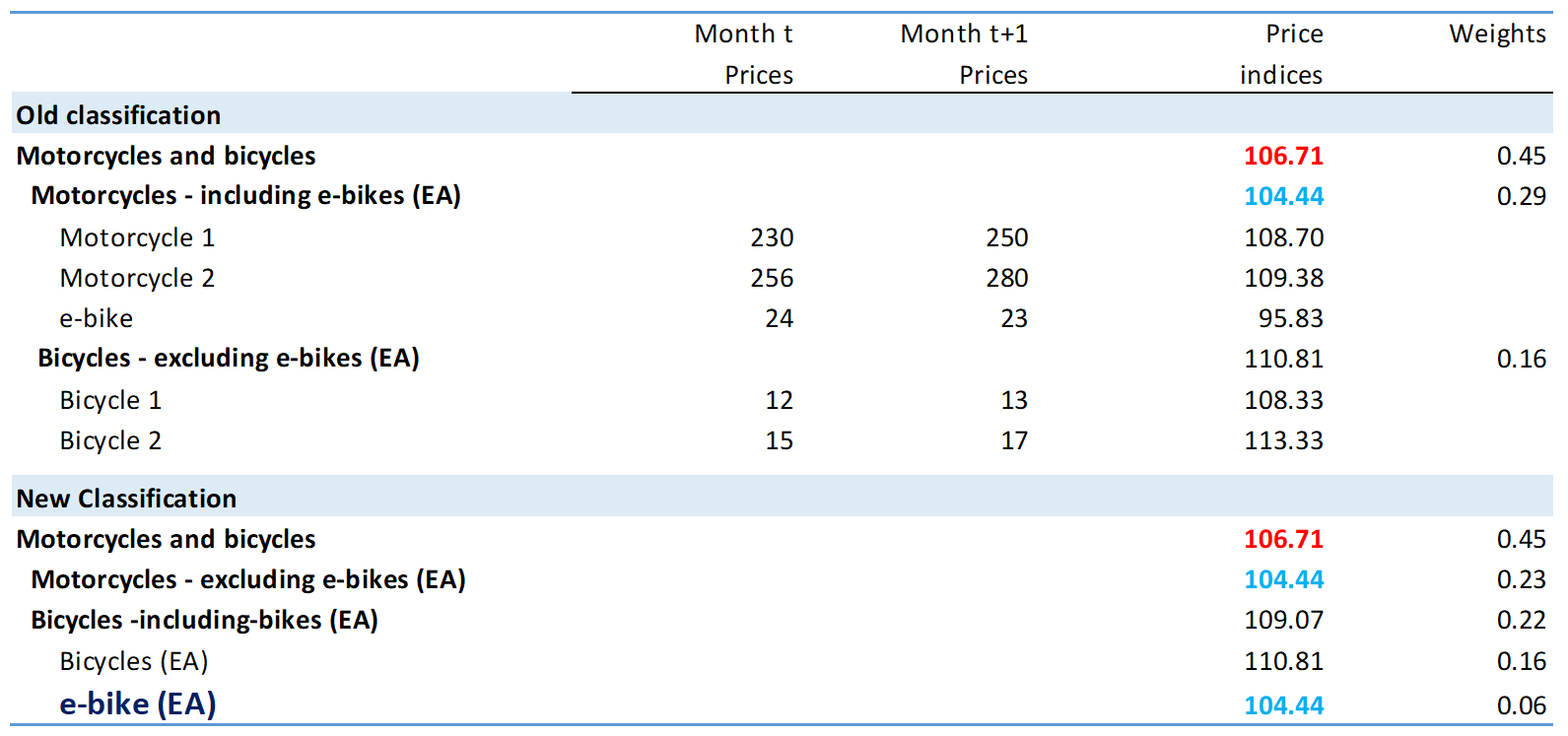
4.7 Key points
Changes in classification should be implemented together with a regular CPI update to reduce breaks in the time series. Standard linking techniques should be applied to link the CPI based on the new classification to the CPI based on the old classification. Linking will make it possible to provide users with a continuous time series without revising historical data.
A continuous time series should be provided, at least for the all-items CPI level. Depending on user needs, publication policy and availability of historical price data, continuous time series could also be published for more detailed aggregates of the new classification. For example, when switching to COICOP18, continuous series could be calculated at the COICOP division level.
In case of significant changes in classification, the NSO could consider updating the index reference period of the CPI and aligning it with the new price reference period. This will facilitate the dissemination of series that cannot be linked backwards and signal to users that there has been an important methodological change.
Series can be linked together if they have similar coverage. In order to align the coverage of the series to be linked, a correspondence table should be built to assign the elementary aggregates of the old classification to the target categories of the new classification. The previous CPI series can then be re-calculated according to the new classification and linked to the updated CPI.



